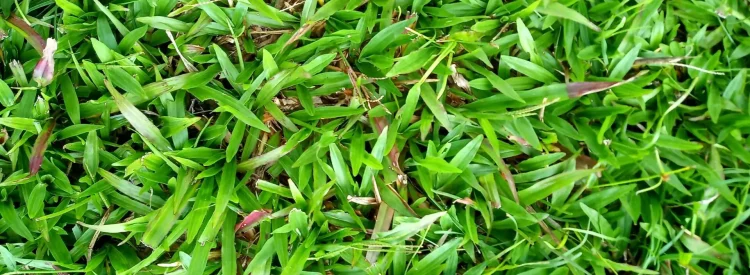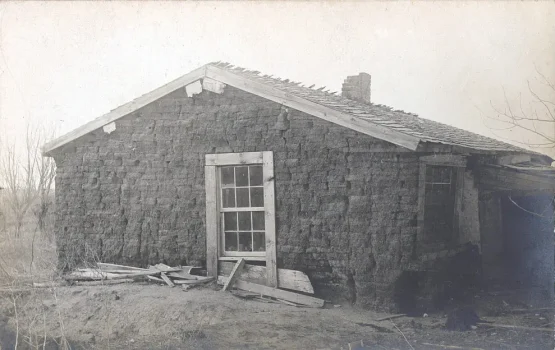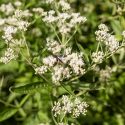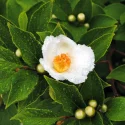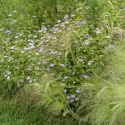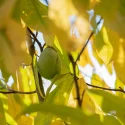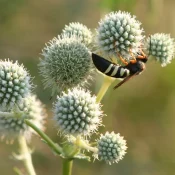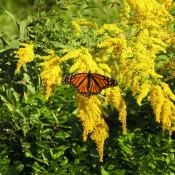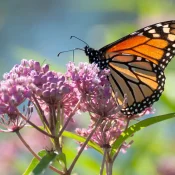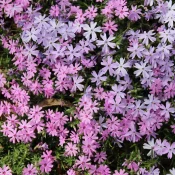The name helps you imagine herds of buffalo happily eating this grass as they roamed the prairies. The grass seed used in most American lawns today comes from northern European grass species, which explains why conventional lawns need so much water to stay green. This tough native grass requires less water and less fertilizer than non-native grasses, making it a great lawn replacement. Scroll on for planting and sourcing tips.
Why buffalo grass matters
Buffalo grass is a low-maintenance, tough grass native to the Great Plains of North America. Imagine thousands of miles of prairie filled with this grass while wild bison roamed and grazed—hence the name.
Because it’s been growing in North America for thousands of years, buffalo grass is built for extremes. It stands up to drought, wind, and temperature swings—and needs a fraction of the water and care of non-native lawns.
Native plants like buffalo grass are the best choice for our yards because they deliver beauty, resilience, and ecological benefits that exotic plants can’t match.
New to native?
Before lawns and landscaping, native plants were here. They’ve fed birds, bees, and butterflies for thousands of years—and they’ll do the same in your yard. The best part? They’re easier to grow than you think.
A quick history of buffalo grass
There are many written accounts of settlers describing rolling acres of buffalo grass when the West was first settled. It was so abundant and sturdy that it was literally used to build homes—early sod houses were made of buffalo grass.
It wasn’t until the 1930s that buffalo grass was first used as turf grass. It once had a reputation for being hard to establish, but newer cultivars make it easier to plant and maintain.
Buffalo grass spreads by stolons, or above-ground runners—like strawberries—allowing it to knit together quickly into a dense, soft turf.
What buffalo grass looks like as a lawn
Buffalo grass looks most like a traditional turf lawn, with thick green blades and a soft texture once established. It can be mowed to 3 inches or left natural at 4–8 inches tall.
Because bison historically grazed it short, buffalo grass evolved to thrive with cutting—meaning it handles mowing beautifully. Its texture can be tougher than non-native grasses—the grass blades are thicker and wider than the standard non-native seed that comes from big box nurseries.
It’s tougher and thicker than imported grasses, but it forms a strong root system that makes it highly drought-resistant and great for erosion control. After the first year, it thrives on rainfall alone.
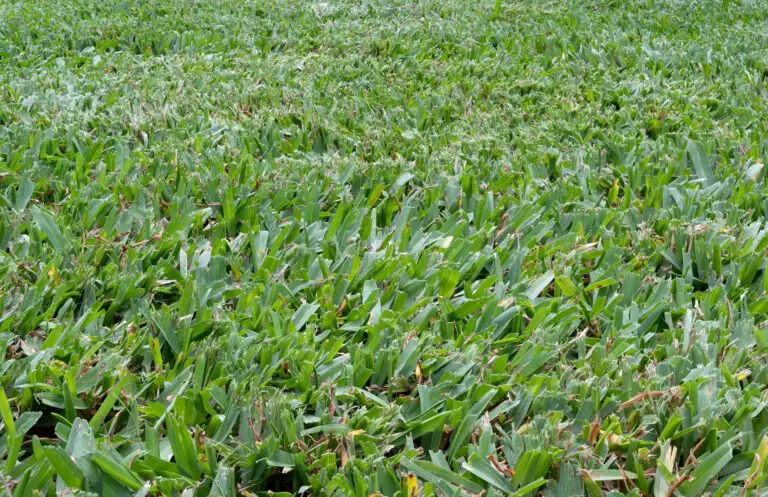
Is buffalo grass a good choice for your yard?
Yes—if:
- You want a low-water, low-mow lawn
- Your space gets at least 6–8 hours of full sun
- You don’t mind it going dormant and tan in winter
- You don’t plan on constant heavy foot traffic (occasional is fine)
Maybe not—if:
- You need a grass that tolerates shade
- You expect a bright green lawn all winter
- You host frequent, high-impact play or sports
A few other tips:
Buffalo grass can’t handle heavy, constant foot traffic. It doesn’t mind being heavily used occasionally or constant light traffic, but it doesn’t do well with both. So if you are playing soccer daily on your grass, you’ll probably want to keep some of it as European lawn.
Try a cultivar to make it easier for lawns
Newer types of Buffalo Grass cultivars have been introduced that work especially well as lawns. Some of the types that Colorado State Extension Service recommends include Bison, Bowie, Cody, Plains, Topgun, Legacy, Prestige, and Turffalo. Check out the Brooklyn Botanic Garden’s guide to the different Buffalo Grass cultivars.
A note for Mid-Atlantic or Southeast gardens:
This might not be your lawn replacement
Buffalo grass thrives in the dry, hot, full sun environment of Midwestern prairies. In a humid or wet environment, it struggles, allowing weeds to quickly overtake the area.
The University of Maryland Center for Environmental Science offers a sobering (and scientifically informed) overview of its candid recommendations against planting buffalo grass in most of Maryland, due to the humid climate.
How to grow buffalo grass
When to plant
Plant in spring once the soil reaches about 60°F. Warm weather helps it establish quickly before winter.
Start with a clean slate
Remove existing grass and weeds before planting—buffalo grass can’t compete with non-native turf. You can till or use an herbicide to clear the area.
Choose your planting method
- Sod: fastest but most expensive
- Seed: cheapest, but slowest to fill in
- Plugs: a good middle ground—space them 6–24 inches apart, and you’ll have a full lawn in 6–12 weeks
A note, if you go the seed route: Give yourself 2-3 years of attention and patience to get it looking lush. The University of Maryland notes in their buffalo grass trials that “In a Virginia roadside trial, buffalograss cover in the second year of growth never exceeded 60% cover.” But a couple of years’ patience does pay off! The same study notes, “In the third year, however, four buffalograss cultivars had an average ground cover above 70% despite a severe summer drought.”
First-year care
Water regularly during the first growing season. After it’s established, it will need 50–75% less water than a conventional lawn. Weed early and often until it fills in.
Ongoing care
Once established, buffalo grass thrives on minimal care. Fertilize once a year if desired, and water only during extended droughts. In full sun and poor soil, it will still thrive.
Brian at Turf Mechanic has a helpful overview if you decide to go the seed route:
Buffalo grass for a…house?
Can you mow buffalo grass?
Yes! After the grass is established, it can be mowed. Just like with European lawngrass, the higher you let it grow, the healthier and more drought-tolerant it will be. Experts recommend mowing it to 3-4 inches. Or you can let it grow naturally for a more meadow-like look—it will top out at about 4-8 inches, depending on the variety.
To keep it looking green, buffalo grass will need about an inch of water every few weeks, usually in the hottest parts of the summer. (If not watered, it’ll simply go dormant and green back up when it rains again.)
Sit back and enjoy your buffalo grass lawn!
We hope you’ve enjoyed learning about this native alternative to European turf grass. To learn more about planting Buffalo Grass as a lawn, check out your local College Extension service. For example, Colorado State and Missouri State have thorough articles to help you. Or, visit our Beginner’s Guide to Native Grasses and Sedges. Happy planting!
Sources
- Brakie, Melinda. U.S. Department of Agriculture, Natural Resources Conservation Service, Buffalograss.
- Eyestone, Greg. Kansas State University Extension. “Buffalograss Lawn”
- Harris, Marjorie. Botanica North America: The Illustrated Guide to Our Native Plants, Their Botany, History, and the Way They Have Shaped Our World. (2003), 289-290.
- Brooklyn Botanic Garden, “Planting and Maintaining a Buffalograss Lawn”
- Colorado State Extension, Buffalograss Lawns
- University of Maryland Center for Environmental Science. Buffalograss Summary (PDF). Cambridge, MD, n.d.
- University of Missouri Extension. “Establishment and Care of Buffalograss Lawns”
What if your feed was actually good for your mental health?
Give your algorithm a breath of fresh air and follow us.
